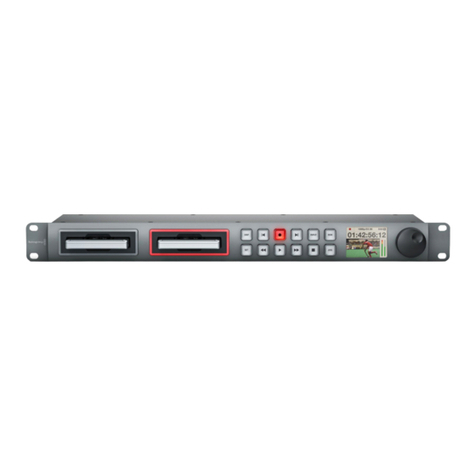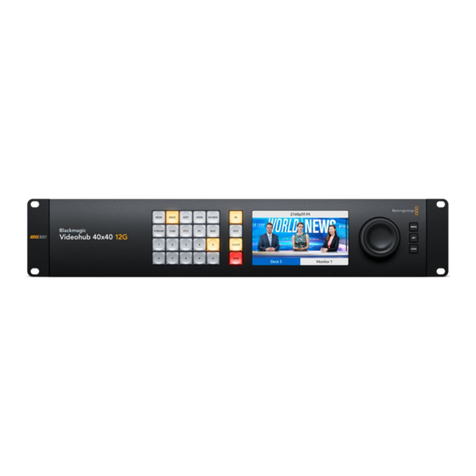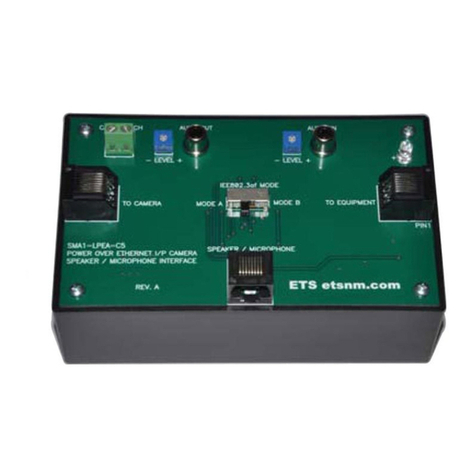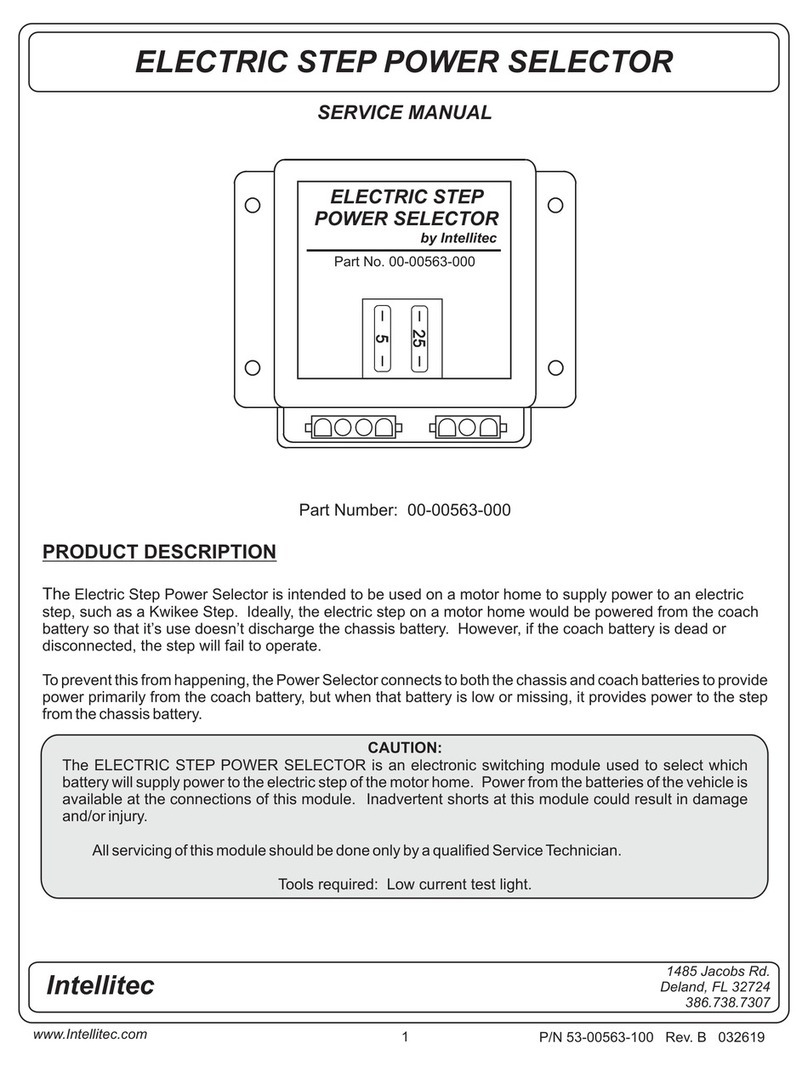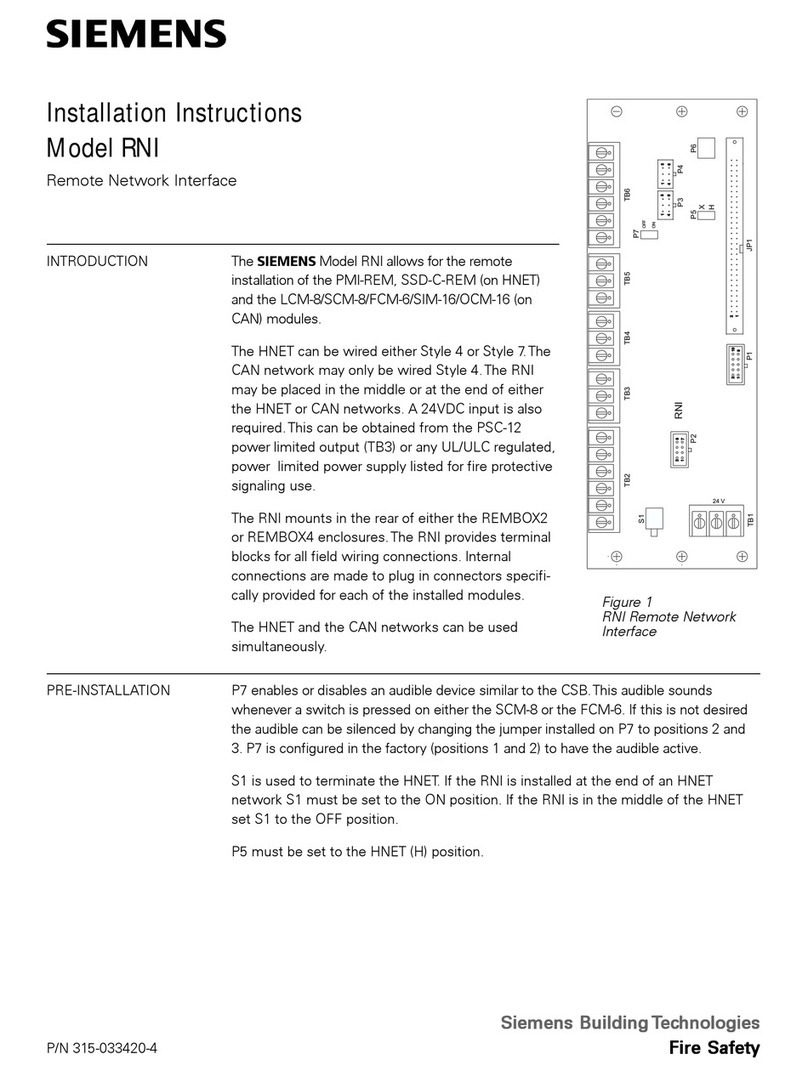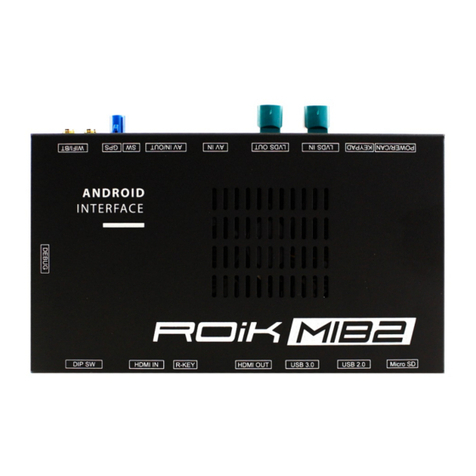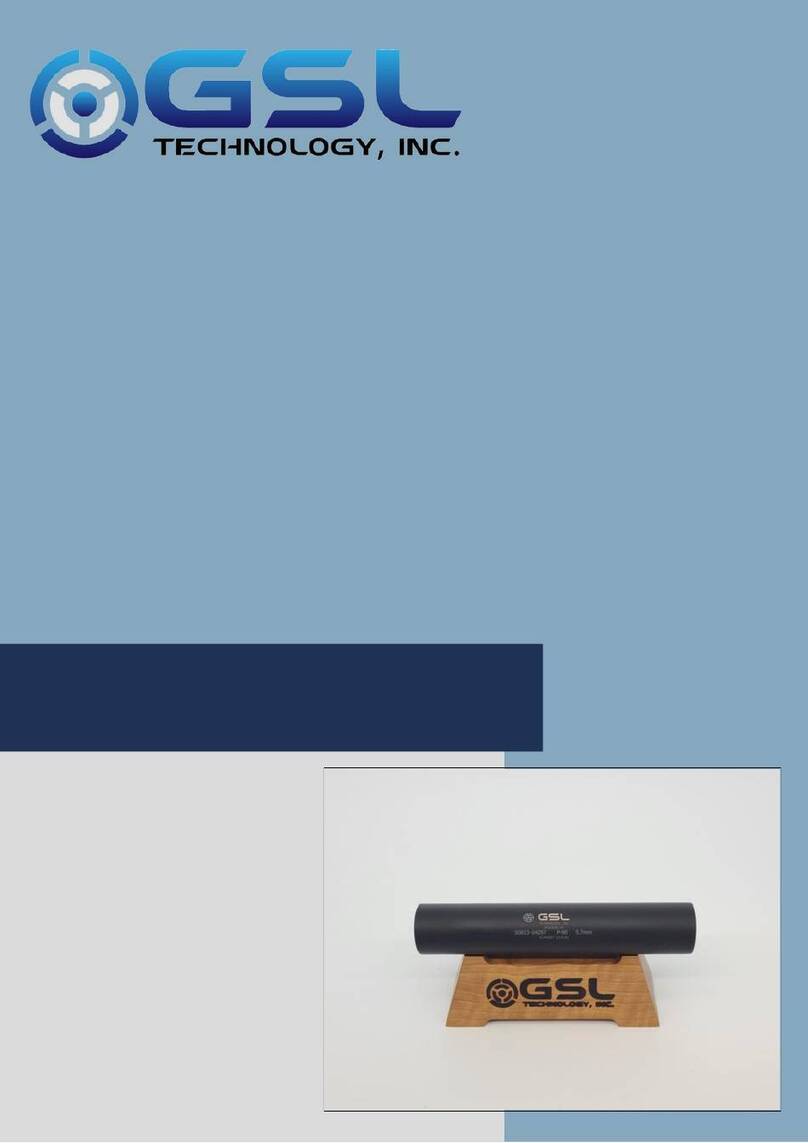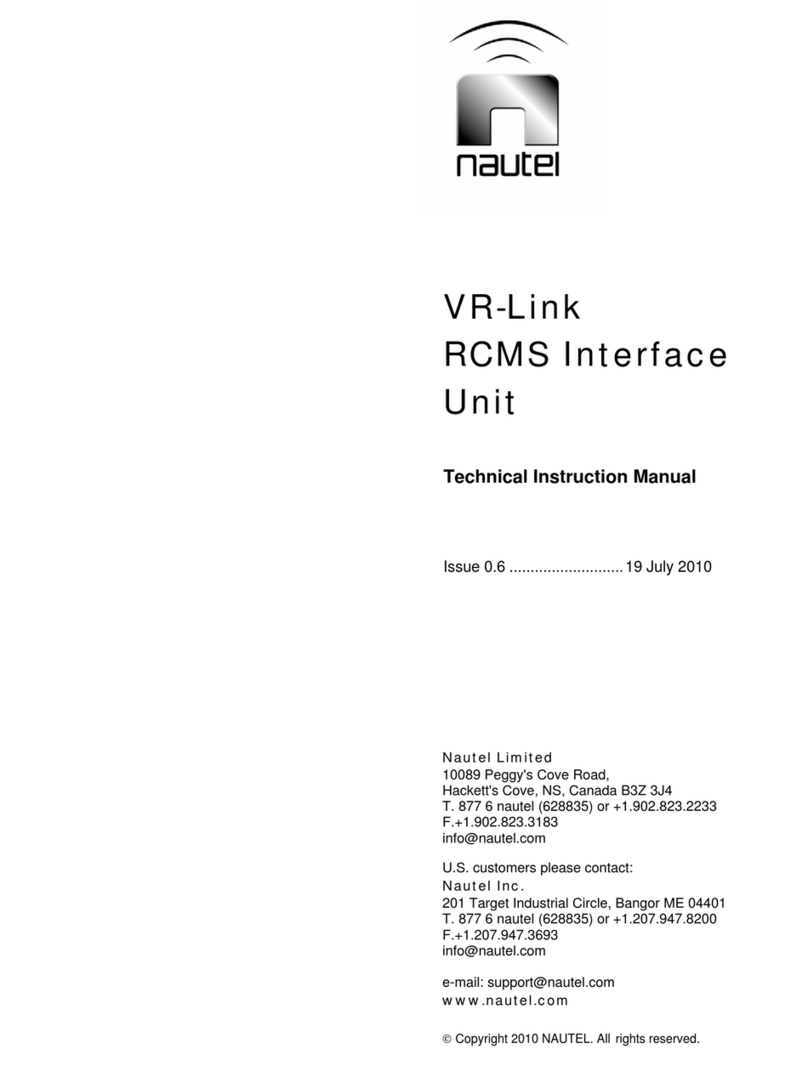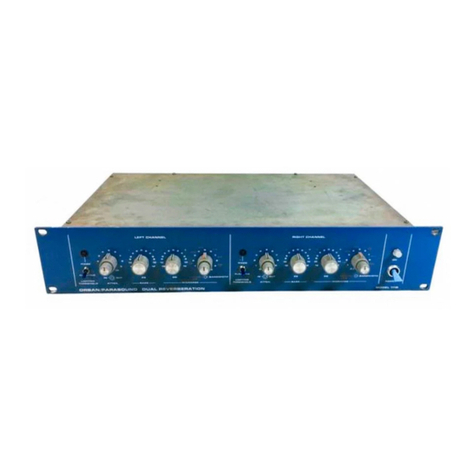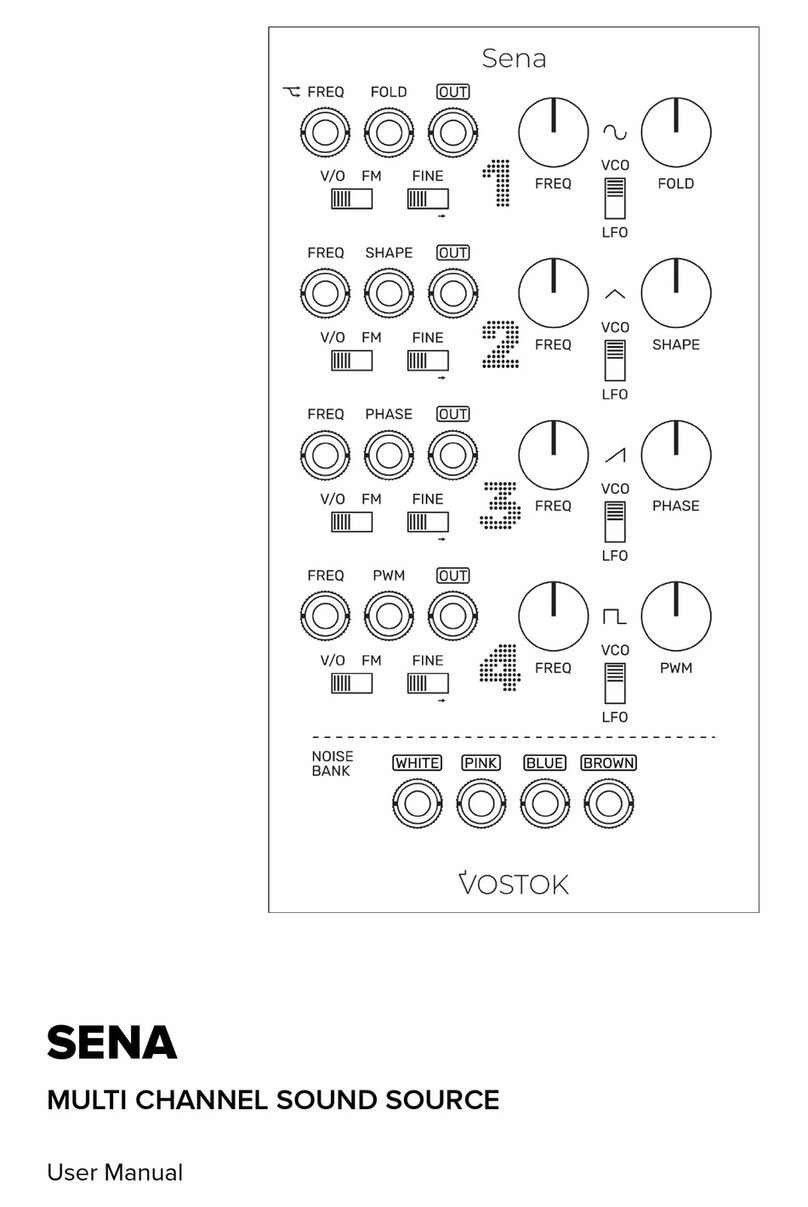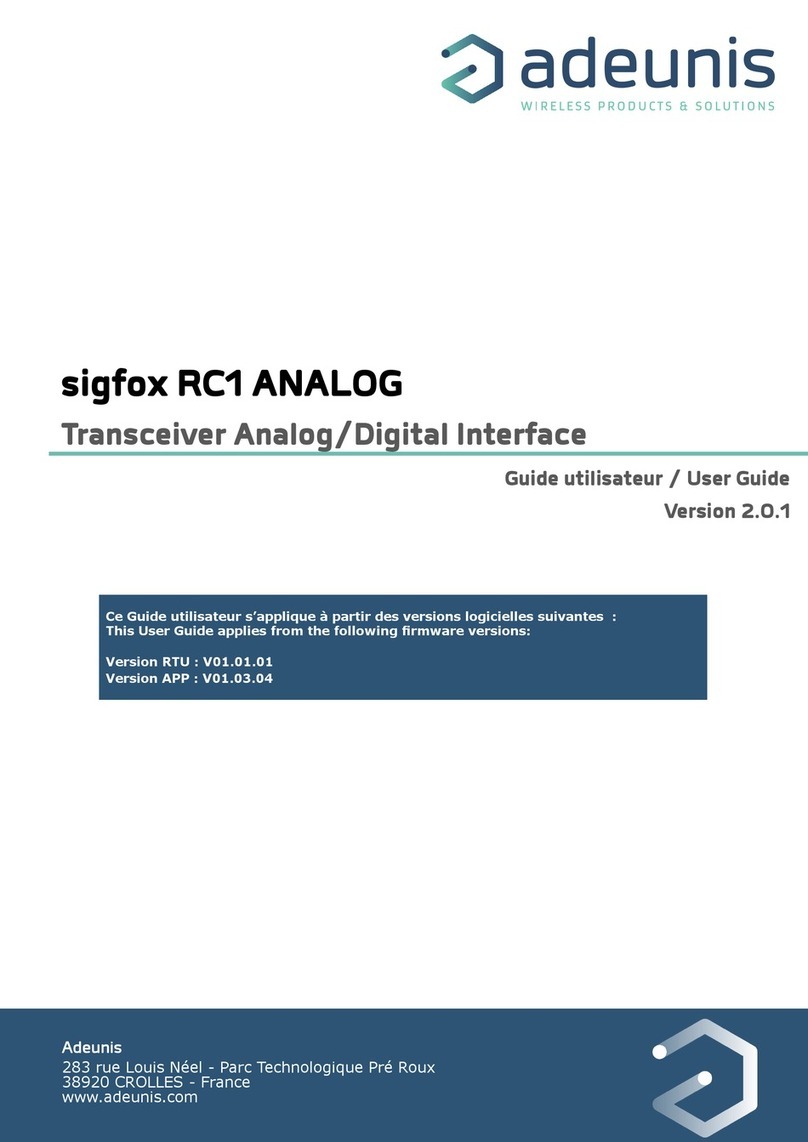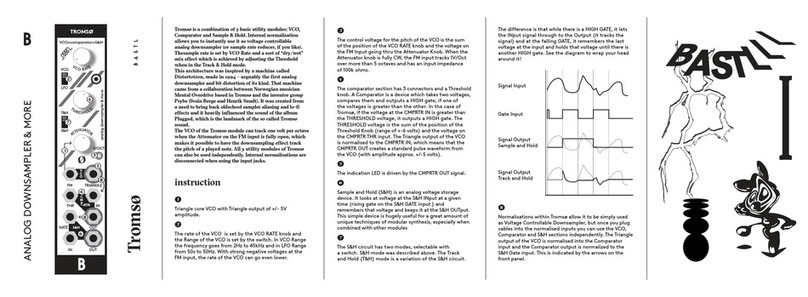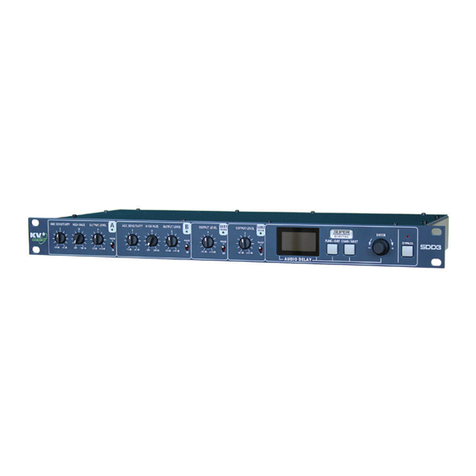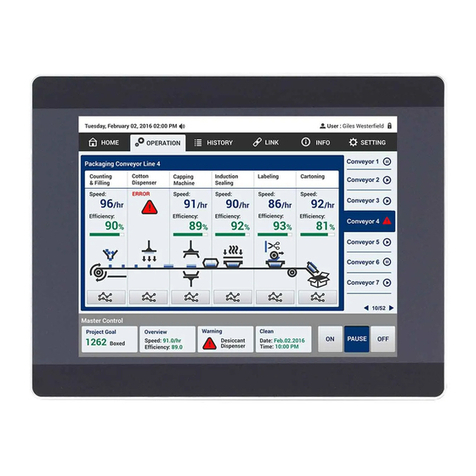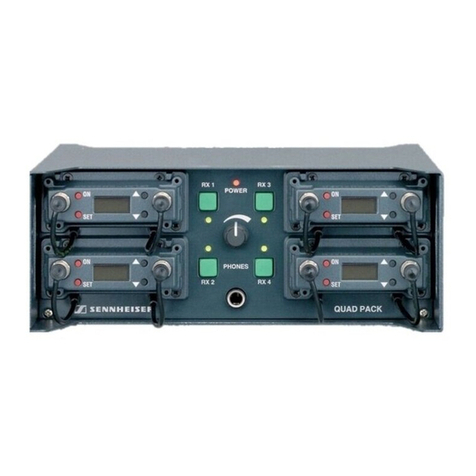Blackmagicdesign HyperDeck Studio User manual

Welcome
We hope you share our dream for the television industry to become a truly creative
industry by allowing anyone to have access to the highest quality video.
Our range of HyperDeck disk recorders have made it easier and more affordable than
ever to record and play back full 10 Bit uncompressed video and now Ultra HD 4K!
HyperDeck records directly to removable 2.5” Solid State Disks (SSDs) that are getting
bigger, faster and more affordable every day. It’s incredible that you can now record
and play the most amazing quality video onto something so small thousands of times
without any degradation in quality!
SSDs can also be mounted on any computer for immediate editing and fast transfer
of your media. With no moving parts, SSDs are unbelievably robust and can handle
harsh conditions that would destroy conventional hard drives and videotapes!
You can bypass unwanted camera compression and record directly from HDMI or
SDI cameras straight to SSD and even connect to any HDMI or SDI monitor for instant
playback! With HyperDeck Studio Pro, you can connect analog sources and also
record and play back Ultra HD 4K with 6G-SDI!
If you need longer recording times for each SSD, then HyperDeck also records and plays
back Apple ProRes and Avid DNxHD files. These 10 Bit quality codecs retain fantastic
picture quality and increase the recording length of SSDs by more than 5 times!
This instruction manual contains all the information you need to start using your
HyperDeck disk recorder. For uncompressed recording you need to use an SSD
that supports the required data speed and we are continually adding details on
our website of new SSDs that we have tested.
Please check the support page at www.blackmagicdesign.com for the latest version of this
manual and updates to the HyperDeck software. Keeping your software up to date will
always ensure you get all the latest features. When downloading software, please register
with your information so we can keep you updated when new software is released. We are
constantly working on new features and improvements, so we would love to hear from you!
Grant Petty
CEO Blackmagic Design

Contents
HyperDeck Disk Recorders
5 Getting Started
Introducing HyperDeck 5
Plugging in Video Sources 6
Connecting Video Outputs 7
Recording Video 7
Playing Video 8
10 Using HyperDeck
About SSDs 10
Choosing a Fast SSD 10
Preparing SSDs for HyperDeck 11
HyperDeck Utility 12
How to Update Your HyperDeck Software on Mac OS X 12
How to Update Your HyperDeck Software on Windows 12
Selecting Your Video Format in HyperDeck Utility 13
About Ultra HD 4K 14
Setting Up Ultra HD 4K Recording 14
Setting Up Ultra HD 4K Playback 14
Accessing Your Clips 15
Mac OS X 15
Windows 15
Status Indicators 15
Using the Display Menu on HyperDeck Studio Models 16
Selecting Timecode Source 17
SDI Start/Stop Recording 17
Timecode Run Recording 18
Shuttling with HyperDeck Shuttle 18
Jog and Shuttle with HyperDeck Studio Models 18
Ref Input 19
RS-422 Control 19
What is RS-422 Control? 19
Using an External RS-422 Controller 19
Daisy-chaining for Crash Recording 20
Supported RS-422 Commands 21
RS-422 Developer Information 25
Installing the HyperDeck Shuttle Mounting Plate 26
27 Using Your Favorite Editing Software
Capturing video via Thunderbolt 27
Capturing from SSD 27
Simultaneous Capture and Recording 27
Avid Media Composer 28
Setting up 28
Capturing live via Thunderbolt 29
Apple Final Cut Pro 7 30
Setting up 30
Capturing live via Thunderbolt 30
Adobe®Photoshop®CC 32

Getting Started
5
Introducing HyperDeck
There are three models of HyperDeck disk recorders, which all have internal 3 Gb/s SATA ports for use
with standard 2.5" SSDs.
HyperDeck Shuttle
HyperDeck Shuttle is compact, affordable and battery powered, so it’s perfect as a field recorder.
HyperDeck Shuttle bypasses your camera’s compression and records from SDI and HDMI directly into the
highest quality uncompressed video. If compressed video better suits your workflow, or if you need to fit
more video on a SSD, the latest model records and plays back Apple ProRes and Avid DNxHD formats.
The HyperDeck Shuttle Mounting Plate can be purchased if you want to secure your HyperDeck Shuttle
to a camera rig with your choice of rail mounts, cold shoe mounts, articulated arms and more. You can
also use the plate to power your HyperDeck Shuttle from an external battery by attaching a V-Mount
or Anton Bauer style battery plate.
HyperDeck Studio
HyperDeck Studio is a rack mount broadcast deck style recorder that features dual SSD slots so it can
automatically continue recording onto another SSD when one is full. Only 1 RU high and less than 4
inches deep, HyperDeck Studio is perfect for when space is tight, such as in broadcast vans and fly
away rack cases.
HyperDeck Studio features uncompressed quality recording and playback, RS-422 deck control, genlock,
jog and shuttle controls and an integrated LCD. It can record and play back in Apple ProRes and Avid
DNxHD formats if compressed video better suits your workflow or if you need to fit more video on a
SSD. Both the HyperDeck Studio and the HyperDeck Studio Pro support the following ProRes codecs:
Prores 422 (HQ)
ProRes 422
ProRes 422 LT
ProRes 422 (Proxy)
HyperDeck Studio Pro
HyperDeck Studio Pro does everything that HyperDeck Studio does, with the addition of analog video
and audio in and out, timecode in and out, Thunderbolt™connectivity, high 1080p frame rates including
50, 59.94 and 60, and Ultra HD 4K ProRes capture and playback via 6G-SDI and HDMI 4K!
Getting Started
HyperDeck Studio
HyperDeck Studio Pro
HyperDeck Shuttle

Getting Started
6
Plugging in Video Sources
HyperDeck Shuttle
Step 1. Power on the unit. If HyperDeck Shuttle does not power on, you may need to charge the
battery. Simply plug in the power adapter and turn HyperDeck Shuttle on. The battery will
continue to charge as long as the power adapter is connected. You can also power it from
an external camera battery as the connector supports an input range of 12V to 18V.
Step 2. Connect your SDI source to the DIN 1.0/2.3 miniature connector. You may need a BNC to
DIN 1.0/2.3 adapter cable for this. If your source is HDMI, connect a Type A HDMI cable
to the HDMI input. If you connect both SDI and HDMI, HyperDeck Shuttle will default to
recording from whichever input was connected first. We recommend having only SDI or HDMI
connected to each input as HyperDeck Shuttle will switch inputs if one is disconnected and
then reconnected.
HyperDeck Studio
Step 1. Power the unit by connecting an IEC power cord with a C13 connector. HyperDeck Studio's
built in international AC power supply supports 110-240V, 50/60 Hz.
Step 2. Connect SDI video sources, such as cameras, routers, switcher outputs or decks to the SDI
inputs. If your source is from HDMI, connect a Type A HDMI cable to the HDMI input.
Step 3. Press the INPUT button once while the stop button is illuminated. The Input button will
illuminate and you will be able to preview the video source on the LCD. If you don’t see the
video you want, press INPUT again to switch inputs.
HyperDeck Studio Pro
Step 1. Power the unit by connecting an IEC power cord with a C13 connector. HyperDeck Studio
Pro's built in international AC power supply supports 110-240V, 50/60 Hz.
Step 2. Connect SDI, HDMI or component sources to their respective inputs. If you are recording
Ultra HD 4K over SDI, the SDI inputs will automatically detect whether you are connecting
via single link 6G-SDI to Input A, dual link 3G-SDI or quad link HD-SDI.
Step 3. If connecting analog audio sources, you can use the XLR inputs for professional balanced
analog audio or the stereo RCA connectors for unbalanced analog audio from consumer
equipment. Connect analog timecode to the XLR timecode input.
Step 4. Press the INPUT button once while the stop button is illuminated. The Input button will
illuminate and you will be able to preview the video source on the LCD. If you don’t see the
video you want, press INPUT again to switch inputs.
+12V POWER
HDMI IN HDMI OUT SDI IN SDI OUT
REMOTE
ETHERNET SD/HD/3GHD-SDI HDMI
IN OUT
REF INMON OUTOUT 2OUT 1LOOP OUTIN
INPUT
DISP
SET
REM
JOG
POWER
REMOTE
IN
SD/HD/3G/6G-SDI IN
TIMECODE
IN OUT CH 1 CH 2 CH 1 CH 2
ANALOG AUDIO IN ANALOG AUDIO OUT
OUT
IN A
Y IN B-Y IN R-Y IN
R-Y OUT REF IN
L
R
STEREO IN
B-Y OUTY OUT
IN B IN C IN D
OUT A OUT B OUT C OUT D MON OUT
ETHERNET
PUSH PUSH
HDMI
PUSH
SD/HD/3G/6G-SDI OUT
REMOTE ETHERNET SD/HD/3GHD-SDI HDMI
IN OUT
REF INMON OUTOUT 2OUT 1LOOP OUTIN
INPUT
DISP
SET
REM
JOG
REMOTE ETHERNET SD/HD/3GHD-SDI HDMI
IN OUT
REF INMON OUTOUT 2OUT 1LOOP OUTIN
INPUT
DISP
SET
REM
JOG
POWER REMOTE
IN
SD/HD/3G/6G-SDI IN TIMECODE
IN OUT CH 1 CH 2 CH 1 CH 2
ANALOG AUDIO IN ANALOG AUDIO OUT
OUT
IN A
Y IN B-Y IN R-Y IN R-Y OUT REF IN
L
R
STEREO IN
B-Y OUTY OUT
IN B IN C IN D OUT A OUT B OUT C OUT D MON OUT
ETHERNET
PUSH PUSH
HDMI
PUSH
SD/HD/3G/6G-SDI OUT
POWER REMOTE
IN
SD/HD/3G/6G-SDI IN TIMECODE
IN OUT CH 1 CH 2 CH 1 CH 2
ANALOG AUDIO IN ANALOG AUDIO OUT
OUT
IN A
Y IN B-Y IN R-Y IN R-Y OUT REF IN
L
R
STEREO IN
B-Y OUTY OUT
IN B IN C IN D OUT A OUT B OUT C OUT D MON OUT
ETHERNET
PUSH PUSH
HDMI
PUSH
SD/HD/3G/6G-SDI OUT
POWER REMOTE
IN
SD/HD/3G/6G-SDI IN TIMECODE
IN OUT CH 1 CH 2 CH 1 CH 2
ANALOG AUDIO IN ANALOG AUDIO OUT
OUT
IN A
Y IN B-Y IN R-Y IN R-Y OUT REF IN
L
R
STEREO IN
B-Y OUTY OUT
IN B IN C IN D OUT A OUT B OUT C OUT D MON OUT
ETHERNET
PUSH PUSH
HDMI
PUSH
SD/HD/3G/6G-SDI OUT
HyperDeck Shuttle HDMI and SDI inputs.
HyperDeck Studio SDI and HDMI inputs
HyperDeck Studio Pro HDMI, analog component
and SDI inputs.

Getting Started
7
REMOTE
ETHERNET SD/HD/3GHD-SDI HDMI
IN OUT
REF INMON OUTOUT 2OUT 1LOOP OUTIN
INPUT
DISP
SET
REM
JOG
Connecting Video Outputs
HyperDeck features outputs for monitoring or connecting to additional recording units. All outputs are
active, so you can record and monitor simultaneously.
HyperDeck Shuttle
Connect either an SDI or HDMI cable to their respective outputs. You may need a DIN 1.0/2.3 to BNC
adapter cable for outputting SDI. Both outputs are active, so you can view your recording on both an
SDI monitor and an HDMI monitor simultaneously.
HyperDeck Studio
Connect an SDI cable to the Loop Out port if you want to connect to another HyperDeck for redundant
recording or to the Monitor output if you want to connect an SDI monitor. You can also connect additional
SDI equipment to the SDI outputs such as additional recorders or monitors.
HyperDeck Studio Pro
Connect SDI, HDMI or component analog cables to their respective outputs. If you want to output Ultra
HD 4K over 6G-SDI, use Output A. HDMI also supports Ultra HD 4K. For SD/HD-SDI monitoring, connect
to the Monitor output. You can also send analog timecode via the XLR timecode output.
Congratulations! You are now ready to start recording!
Recording Video
HyperDeck ships ready to record immediately without having to configure any settings. All you need is
a recommended SSD formatted in the HFS+ or exFAT format. If HyperDeck records from a video source
that contains closed caption data, the QuickTime or MXF movie will be recorded as well as a separate
.MCC file containing the closed caption data.
Recording Video with HyperDeck Shuttle
Step 1. Insert your formatted SSD. As HyperDeck Shuttle reads the disk, the SSD light will illuminate.
When the light goes off, HyperDeck Shuttle is ready to record.
Step 2. HyperDeck Shuttle automatically detects whether SDI or HDMI is connected. The Video
status LED lights up when a valid video signal is detected.
Step 3. Press the Record button and the SSD light will flash to indicate SSD activity. If the Stop button
starts flashing while recording, there are only 3 minutes of recording time left on the SSD.
Make sure you have another empty SSD ready so you don’t miss the next take.
Step 4. Press the Stop button to finish recording.
POWER REMOTE
IN
SD/HD/3G/6G-SDI IN
TIMECODE
IN OUT CH 1 CH 2 CH 1 CH 2
ANALOG AUDIO IN ANALOG AUDIO OUT
OUT
IN A
Y IN B-Y IN R-Y IN R-Y OUT
REF IN
L
R
STEREO IN
B-Y OUTY OUT
IN B IN C IN D OUT A OUT B OUT C OUT D
MON OUT
ETHERNET
PUSH PUSH
HDMI
PUSH
SD/HD/3G/6G-SDI OUT
REMOTE ETHERNET SD/HD/3GHD-SDI HDMI
IN OUT
REF INMON OUTOUT 2OUT 1LOOP OUTIN
INPUT
DISP
SET
REM
JOG
POWER REMOTE
IN
SD/HD/3G/6G-SDI IN TIMECODE
IN OUT CH 1 CH 2 CH 1 CH 2
ANALOG AUDIO IN ANALOG AUDIO OUT
OUT
IN A
Y IN B-Y IN R-Y IN R-Y OUT REF IN
L
R
STEREO IN
B-Y OUTY OUT
IN B IN C IN D OUT A OUT B OUT C OUT D MON OUT
ETHERNET
PUSH PUSH
HDMI
PUSH
SD/HD/3G/6G-SDI OUT
REMOTE ETHERNET SD/HD/3GHD-SDI HDMI
IN OUT
REF INMON OUTOUT 2OUT 1LOOP OUTIN
INPUT
DISP
SET
REM
JOG
POWER REMOTE
IN
SD/HD/3G/6G-SDI IN TIMECODE
IN OUT CH 1 CH 2 CH 1 CH 2
ANALOG AUDIO IN ANALOG AUDIO OUT
OUT
IN A
Y IN B-Y IN R-Y IN R-Y OUT REF IN
L
R
STEREO IN
B-Y OUTY OUT
IN B IN C IN D OUT A OUT B OUT C OUT D MON OUT
ETHERNET
PUSH PUSH
HDMI
PUSH
SD/HD/3G/6G-SDI OUT
POWER REMOTE
IN
SD/HD/3G/6G-SDI IN TIMECODE
IN OUT CH 1 CH 2 CH 1 CH 2
ANALOG AUDIO IN ANALOG AUDIO OUT
OUT
IN A
Y IN B-Y IN R-Y IN R-Y OUT REF IN
L
R
STEREO IN
B-Y OUTY OUT
IN B IN C IN D OUT A OUT B OUT C OUT D MON OUT
ETHERNET
PUSH PUSH
HDMI
PUSH
SD/HD/3G/6G-SDI OUT
HyperDeck Shuttle HDMI and SDI outputs.
HyperDeck Studio SDI and HDMI outputs. SDI outputs
include a Loop Out and a Monitor output.
HyperDeck Studio Pro HDMI, analog component and SDI
outputs plus Monitor Out.
+12V POWER
HDMI IN HDMI OUT SDI IN SDI OUT
The record button lights up red when HyperDeck Shuttle
is recording video.
DISP VIDEO
DISP VIDEO

Getting Started
8
Recording Video with HyperDeck Studio Models
Step 1. Insert your formatted SSD into either SSD slot. The slot light will illuminate green as HyperDeck
reads the disk. When the slot light goes off, HyperDeck Studio is ready to record.
Step 2. Press the INPUT button once while the stop button is illuminated. The Input button will
illuminate and you will be able to preview the video source on the LCD before recording.
If you don’t see the video you want, press INPUT again to switch inputs.
Step 3. Press the record button to start recording to the SSD instantly. A looping red light on the
SSD slot indicates the SSD is recording. During recording, you can press and hold the record
button to switch recording from one SSD to the other instantly.
Step 4. Press the Stop button to finish your recording.
If the record button flashes, this means the disk is not fast enough and recording cannot keep up. We
recommend you change to a compressed recording format such as ProRes or DNxHD, or use a faster
recommended SSD for uncompressed or Ultra HD 4K recording.
Playing Video
The controls of HyperDeck work just like a CD player, so playing back clips is simple and instantaneous.
If you play back a video clip that has an associated .MCC file, the closed caption data will be played out
with the video via the SDI output of your HyperDeck.
Playing Video with HyperDeck Shuttle
Step 1. Press the Stop button once to stop recording.
Step 2. Press Stop again to switch HyperDeck Shuttle to playback mode.
Step 3. Press Play and you'll see your video on any displays connected to the SDI and HDMI outputs.
When a clip is playing, pressing Play again will loop it continuously.
Step 4. To skip to the next clip, press the next clip button on the shuttle controls. Press previous
clip once to go to the start of the current clip or press twice to skip back to the start of the
previous clip.
Playing Video with HyperDeck Studio models
Step 1. Press the Stop button once to stop recording.
Step 2. Press the play button once for instant playback and you'll see your video on any displays
connected to the SDI and HDMI outputs. When a clip is playing, pressing Play again will
loop it continuously.
SSD slots on HyperDeck Studio models have rotating LEDs to
show the unit is recording video.
INPUT
DISP
SET
REM
JOG
01:42:56:12
SSD 2
INPUT
DISP
SET
REM
JOG
01:42:56:12
SSD 2
DISP VIDEO
DISP VIDEO
The play button lights up green when HyperDeck Shuttle
is in playback mode.

Getting Started
9
Step 3. To skip to the next clip, press the next clip button on the shuttle controls.
Step 4. Press previous clip once to go to the start of the current clip or press twice to skip back to
the start of the previous clip.
If the play button flashes, this means the disk is not fast enough and playback cannot keep up. We
recommend you change to a compressed recording format such as ProRes or DNxHD, or use a faster
recommended SSD for uncompressed or Ultra HD 4K recording.
Congratulations! Your HyperDeck is now up and running. Please continue to the next sections of this
manual for more information on what you can do with your HyperDeck.
SSD slots on HyperDeck Studio models have rotating LEDs to
show the unit is in playback mode.
01:42:56:12
SSD 2
INPUT
DISP
SET
REM
JOG
01:42:56:12
SSD 2
INPUT
DISP
SET
REM
JOG

Using HyperDeck
10
Sandisk Extreme 480GB SSD
About SSDs
Choosing a Fast SSD
When working with high data rate video it's important to carefully check the SSD you would like to use.
This is because some SSDs can have up to 50% lower write speed than the manufacturer’s claimed speed,
so even though the disk specifications claim an SSD is fast enough to handle video, in reality the disk is
not fast enough for real time video recording. Hidden data compression mostly affects recording and
often these disks can still be used for real time playback.
In our testing, we have found larger newer models of SSD and larger capacity SSDs are generally faster.
SSDs recommended for use with HyperDeck for uncompressed 10 Bit HD and ProRes Ultra HD 4K video
recording include:
Crucial 512GB M4 (firmware 009 only)
Digistor – 128GB SSD Professional Video Extreme
Digistor – 240GB SSD Professional Video Series
Digistor – 480GB SSD Professional Video Series
Intel 335 Series 240GB SSD
Intel 520 Series 240GB SSD
Intel 520 Series 480GB SSD
Kingston 120GB SSDNow V+200
Kingston 240GB SSDNow V+200
Kingston HyperX 240GB
OCZ 240GB Deneva 2 (firmware 2.22)
OCZ 240GB Vertex 3
OCZ 480GB Vertex 3
OWC Mercury Extreme Pro 6G SSD
PNY 240GB Prevail SSD (firmware 5.0.2)
Sandisk Extreme 480GB
Please check the tech notes on the Blackmagic Design website for the latest information.
If you find an SSD that isn’t fast enough for uncompressed HD video or Ultra HD 4K, try a faster SSD or
use HyperDeck Utility to switch to a compressed recording format such as ProRes or DNxHD. These
recording formats have a much lower data rate and are easier for the SSD to handle.
Kingston HyperX 240GB SSD
Intel 335 Series 240GB SSD
Using HyperDeck

Using HyperDeck
11
Preparing SSDs for HyperDeck
SSDs used by HyperDeck must be formatted as either HFS+ or exFAT. These disk formats allow long
clips to be recorded in single files.
HFS+ is also known as Mac OS Extended. It is the recommended format for HyperDeck as it supports
"journaling". In the event of a hardware or software malfunction, data on a journaled SSD is more quickly
recovered and less likely to be corrupted in the first place. HFS+ is natively supported by Mac OS X.
ExFAT is supported natively by Mac OS X and Windows without needing to purchase any additional
software. However exFAT does not support journaling which means data is more prone to corruption,
and less likely to be recovered in the event of a hardware or software malfunction.
Preparing SSDs on a Mac OS X computer
The Disk Utility application included with Mac OS X can format a drive in the HFS+ or exFAT formats. Make
sure you back up anything important from your SSD as you will lose everything on it when it is formatted.
Step 1. Connect the SSD to your computer with an external dock or cable adapter and dismiss any
message offering to use your SSD for Time Machine backups.
Step 2. Go to Applications/Utilities and launch Disk Utility.
Step 3. Click on the disk icon of your SSD and then click the Erase tab.
Step 4. Set the Format to Mac OS Extended (Journaled) or exFAT.
Step 5. Type a Name for the new volume and then click Erase. Your SSD will quickly be formatted
and made ready for use with HyperDeck.
Preparing SSDs on a Windows computer
The Format dialog box can format a drive in the exFAT format on a Windows PC. Make sure you back
up anything important from your SSD as you will lose everything on it when it is formatted.
Step 1. Connect the SSD to your computer.
Step 2. Open the Start Menu or Start Screen and choose Computer. Right-click on your SSD.
Step 3. From the contextual menu, choose Format.
Step 4. Set the file system to exFAT and the allocation unit size to 128 kilobytes.
Step 5. Type a volume label, select Quick Format and click Start.
Step 6. Your SSD will quickly be formatted and made ready for use with HyperDeck.
Use Disk Utility on Mac OS X to erase your SSD in the
Mac OS Extended (Journaled) or exFAT format.
Use the Format dialog box feature
in Windows to format your SSD
in the exFAT format.

Using HyperDeck
12
HyperDeck Utility
Blackmagic HyperDeck Utility is used to change settings and update the internal software in your
HyperDeck. In addition to installing HyperDeck Utility, uncompressed 10 bit codecs are installed for Mac
and Windows. The HyperDeck Installer software also installs Blackmagic System Preferences, which allow
your favorite video editing software to perform live capture from HyperDeck Studio Pro via Thunderbolt.
Blackmagic system preferences provide a central location so you don't need to configure the same
software settings in each video application that you use.
On Mac OS X, open the System Preferences and click the Blackmagic Design icon. When using HyperDeck
Studio Pro, settings are grayed out and the main use of the Blackmagic system preferences is to tell you
which version of Desktop Video software is installed for video capture via a Thunderbolt port.
When other Blackmagic video capture hardware is connected to your computer, additional settings
may be available.
How to Update Your HyperDeck Software on Mac OS X
Step 1. Download and unzip the HyperDeck Utility software.
Step 2. Open the resulting disk image and launch the HyperDeck Installer. Follow the onscreen
instructions.
Step 3. After installing the latest Blackmagic HyperDeck Utility, connect a USB cable from HyperDeck
to your computer.
Step 4. Launch Blackmagic HyperDeck Utility and follow any onscreen prompt to update the internal
software in your HyperDeck. If no prompt appears, the internal software is up to date and
there is nothing further you need to do.
How to Update Your HyperDeck Software on Windows
Step 1. Download and unzip the HyperDeck Utility software.
Step 2. You should see a HyperDeck Utility folder containing this manual and the HyperDeck Utility
installer. Double-click the installer and follow the onscreen prompts to complete the installation.
Step 3. After installing the latest Blackmagic HyperDeck Utility, connect a USB cable from HyperDeck
to your computer.
Step 4. Launch Blackmagic HyperDeck Utility and follow any onscreen prompt to update the internal
software in your HyperDeck. If no prompt appears, the internal software is up to date and
there is nothing further you need to do.

Using HyperDeck
13
Selecting Your Video Format in HyperDeck Utility
All current HyperDeck models let you select from a choice of uncompressed and compressed video
formats. The original HyperDeck Shuttle exclusively records uncompressed video.
HyperDeck can record 10-bit uncompressed QuickTime files on a fast SSD, or to a compressed format
if you have a slower SSD or want to fit longer high definition recordings on a single SSD. This means
if you have used the HyperDeck Utility software to change the recording format, it is possible to have
uncompressed QuickTime files as well as compressed files on the same disk.
Working with uncompressed video is exciting as there is simply no better quality. However, if compressed
video better suits your workflow, or if you need to fit more video on a SSD, you can choose a high quality
professional compressed video format which is also perfect for editing.
HyperDeck Studio Pro records Ultra HD 4K video using Apple ProRes codecs, which are high quality
compressed codecs designed for post production.
To choose a video format:
Step 1. Connect HyperDeck to your computer via USB.
Step 2. Launch HyperDeck Utility. Your HyperDeck model will be named in the title bar of the utility.
Step 3. Set the recording format from the dropdown menu and save the setting.
All subsequent clips will be recorded in the chosen format.
Setting the recording format also sets the playback format. For example, if you want to play back an
uncompressed 10-bit QuickTime file, set the recording format to Uncompressed 10 Bit QuickTime.
Setting Avid DNxHD as the recording format lets you play DNxHD QuickTime and MXF clips, and by
selecting Apple ProRes you can play clips using any of the ProRes codecs.
ProRes codecs include:
ProRes 422 (HQ) - For the highest quality compression at the maximum ProRes data rate.
ProRes 422 - For extremely high quality compression using a low ProRes data rate.
ProRes 422 LT - For high quality compression at a lower ProRes data rate.
ProRes 422 (Proxy) - For high quality offline compression at the lowest ProRes data rate.
ProRes clips will play back using the compression quality they were recorded in.
+12V POWER HDMI IN HDMI OUT SDI IN SDI OUT
+12V POWER HDMI IN HDMI OUT SDI IN SDI OUT
REMOTE ETHERNET
SD/HD/3GHD-SDI HDMI
IN OUT
REF INMON OUTOUT 2OUT 1LOOP OUT
IN
INPUT
DISP
SET
REM
JOG
POWER REMOTE
IN
SD/HD/3G/6G-SDI IN
TIMECODE
IN OUT CH 1 CH 2 CH 1 CH 2
ANALOG AUDIO IN ANALOG AUDIO OUT
OUT
IN A
Y IN B-Y IN R-Y IN
R-Y OUT REF IN
L
R
STEREO IN
B-Y OUTY OUT
IN B IN C
IN D OUT A OUT B OUT C OUT D MON OUT
ETHERNET
PUSH PUSH
HDMI
PUSH
SD/HD/3G/6G-SDI OUT
POWER REMOTE
IN
SD/HD/3G/6G-SDI IN TIMECODE
IN OUT CH 1 CH 2 CH 1 CH 2
ANALOG AUDIO IN ANALOG AUDIO OUT
OUT
IN A
Y IN B-Y IN R-Y IN R-Y OUT REF IN
L
R
STEREO IN
B-Y OUTY OUT
IN B IN C IN D OUT A OUT B OUT C OUT D MON OUT
ETHERNET
PUSH PUSH
HDMI
PUSH
SD/HD/3G/6G-SDI OUT
REMOTE ETHERNET SD/HD/3GHD-SDI HDMI
IN OUT
REF INMON OUTOUT 2OUT 1LOOP OUTIN
INPUT
DISP
SET
REM
JOG
HyperDeck Shuttle USB port
Selecting your recording and playback format. HyperDeck
Studio Pro includes additional ProRes codecs.
HyperDeck Studio USB port
HyperDeck Studio Pro USB port

Using HyperDeck
14
About Ultra HD 4K
With four times as many pixels as full HD 1080p, Ultra HD 4K is the new standard for high resolution
video. This means you get 3840 x 2160 pixel resolution, allowing you the greatest creative control for
pixel perfect compositing, VFX work, color grading as well as the ability to project onto large displays
for digital signage and cinema projections.
HyperDeck Studio Pro features 6G-SDI technology, which is easily fast enough to handle Ultra HD 4K
playback to the latest 4K monitors. Previously you would have required 4 separate cables to get Ultra
HD resolution over SDI, but now with the amazing data rate 6G-SDI offers, you can get Ultra HD 4K
video over a single cable!
Setting Up Ultra HD 4K Recording
HyperDeck Studio Pro records Ultra HD 4K straight to the Apple ProRes codec. ProRes is the most user
friendly codec because it is QuickTime based, so your Ultra HD 4K footage can be imported to any
QuickTime compatible software. See the previous page for a description of each available ProRes codec.
Step 1. Connect your Ultra HD 4K source to SDI or HDMI inputs. The SDI inputs will automatically
detect if you are connecting via single link 6G-SDI, dual link 3G-SDI or quad link HD-SDI.
Step 2. Press the DISP button on the front of HyperDeck Studio Pro. Use the jog/shuttle wheel to
select Record then press the SET button. Use the jog/shuttle wheel to select the desired
Codec, then press the SET button to confirm.
Step 2. Press the INPUT button once while the stop button is illuminated. The Input button will
illuminate and you will be able to preview the video source on the LCD before recording.
Step 3. Press the record button to start recording your Ultra HD 4K source.
Setting Up Ultra HD 4K Playback
You can set the output through which HyperDeck Studio Pro will playback Ultra HD 4K with the Display
menu on the LCD:
Step 1. Press the DISP button on the front of HyperDeck Studio Pro.
Step 2. Press the SET button to enter the Video menu.
Step 3. Use the jog/shuttle wheel to select 4K SDI Out. Press SET to enter the menu and scroll between
Single 6G-SDI, Dual 3G-SDI or Quad HD-SDI. Press SET to confirm your selection.
Step 4. Press the DISP button to exit back to your video feed.
Choose between single link 6G-SDI, dual link 3G-SDI or
quad link HD-SDI for Ultra HD 4K playback.
Ultra HD 4K is 4 times the resolution of HD.
SD (720x480)
HD (1920x1080)
Ultra HD 4K (3840x2160)
INPUT
DISP
SET
REM
JOG
4K SDI Out
Dual 3G-SDI
Quad HD-SDI
Video In
4K SDI Out
Single 6G-SDI
INPUT
DISP
SET
REM
JOG
4K SDI Out
Dual 3G-SDI
Quad HD-SDI
Video In
4K SDI Out
Single 6G-SDI

Using HyperDeck
15
Accessing Your Clips
To access your clips, simply connect the SSD to your computer using an SSD dock. You can either drag
the files from the SSD directly to a local hard drive, or you can work directly from the SSD. You can also
connect the SSD to your computer with a 2.5" eSATA to USB cable adapter, however this won't be fast
enough to handle working directly from the SSD and is really only recommended as a portable solution
for getting your video files off the SSD and onto a laptop.
Mac OS X
QuickTime is built into Mac OS X. Apple ProRes and uncompressed QuickTime movies recorded by
HyperDeck can be opened in almost any video software on Mac OS X.
DNxHD MXF files recorded by HyperDeck can be opened with Avid Media Composer and DaVinci
Resolve for Mac.
MCC closed caption data files recorded by HyperDeck can be opened with MacCaption software for
Mac OS X from http://www.cpcweb.com.
Windows
Apple ProRes and uncompressed QuickTime movies recorded by HyperDeck require QuickTime
to be installed on your PC. Almost any video software on Windows that supports QuickTime can
open movies recorded by HyperDeck. QuickTime for Windows can be downloaded free from
http://www.apple.com/quicktime/download/.
DNxHD MXF files recorded by HyperDeck can be opened with Avid Media Composer and DaVinci
Resolve for Windows.
MCC closed caption data files recorded by HyperDeck can be opened with CaptionMaker software for
Windows from http://www.cpcweb.com.
Status Indicators
When recording or playing video with HyperDeck, any information you need to know is displayed on
the unit itself. HyperDeck Shuttle's backlit buttons and LEDs provide vital information such as when your
disk is nearly full and the remaining battery life, whereas HyperDeck Studio models display information
on a LCD.

Using HyperDeck
16
HyperDeck Shuttle
SSD Indicator
When you first switch on HyperDeck Shuttle, or any time you insert an SSD, the SSD indicator will light
up while checking the SSD and then switch off. If the SSD has not been formatted correctly, or fails to
work, the SSD indicator will illuminate solid red until the SSD is removed. Check if the SSD is formatted
correctly and also check that it works with a computer.
Video Indicator
The VIDEO indicator lights up when a video signal is detected by HyperDeck Shuttle.
Battery Indicator
The four green battery indicators display the internal battery charge level. When all the LEDs go off,
there’s approximately 4 minutes of battery power left. So you should plug in your external power source
or switch to another charged HyperDeck Shuttle.
HyperDeck Studio Models
SSD Slot
When you first power on HyperDeck, or any time you insert an SSD, the SSD slot will light up while
checking the SSD and then switch off. If the SSD has not been formatted correctly, or fails to work, the
SSD slot will illuminate solid red until the SSD is removed. Check if the SSD is formatted correctly and
also check that it works with a computer.
LCD
HyperDeck Studio models feature an LCD that not only shows your video but also displays status
information such as video format and frame rate, record, playback and jog modes, the active SSD slot
as well as timecode and audio levels.
Using the Display Menu on HyperDeck Studio Models
On HyperDeck Studio models you can use the Display menu to change your video and audio inputs
and outputs as well as any settings changes you would make in the HyperDeck Utility such as trigger
recording, timecode source and your chosen recording codec.
Step 1. Press the DISP button to bring up the main menu.
Step 2. Use the jog/shuttle wheel on the front of HyperDeck to highlight different options.
Step 3. Press the SET button to confirm a selection.
Step 4. To return to a previous menu, scroll to the return arrow and press SET.
Step 5. Press the DISP button to exit.
DISP VIDEO
DISP VIDEO
DISP VIDEO
DISP VIDEO
Status indicators on HyperDeck Shuttle tell you whether your
SSD is formatted correctly, whether a video signal is detected
and how much battery power is left.
The SSD slots on HyperDeck Studio models indicate if an SSD
is formatted correctly and whether the unit is in recording or
playback mode. The LCD on HyperDeck Studio models shows
your video as well as status information.
01:42:56:12
SSD 2
INPUT
DISP
SET
REM
JOG
01:42:56:12
SSD 2
INPUT
DISP
SET
REM
JOG
INPUT
DISP
SET
REM
JOG
01:42:56:12
SSD 2
You can use the DISP menu on HyperDeck Studio models
to select between recording in uncompressed, ProRes or
DNxHD. HyperDeck Studio Pro includes four ProRes codecs.
INPUT
DISP
SET
REM
JOG
Codec
ProResHQ
ProRes
ProResLT
ProResProxy
Codec
Record
Trigger
Uncomp10-bit
INPUT
DISP
SET
REM
JOG
Codec
ProRes HQ
ProRes
ProRes LT
ProRes Proxy
Codec
Record
Trigger
Uncomp 10-bit

Using HyperDeck
17
Selecting Timecode Source
When recording from HD-SDI video sources that provide embedded SMPTE RP 188 metadata,
you can record the embedded timecode from the video source instead of using timecode generated
by your HyperDeck.
To set this on HyperDeck Studio models using the Display menu:
Step 1. Press the DISP button to bring up the main menu.
Step 2. Scroll to the Timecode menu and press SET.
Step 3. Press SET to enter the Timecode Source menu and select Input.
Step 4. Press SET to confirm your selection.
It might be necessary to turn on the RP 188 setting in your camera before HyperDeck will be able to
record the timecode.
SDI Start/Stop Recording
HyperDeck supports start/stop recording, which means when you press the record button on an HD-
SDI camera, HyperDeck will start recording without also having to press the record button on your
HyperDeck disk recorder.
To set up start/stop recording for supported cameras:
Step 1. You will need a camera that can trigger the record function of HyperDeck via HD-SDI. Cameras
which support trigger recording via HD-SDI may include menu options such as "Trigger REC",
"HD-SDI Remote I/F" or "SDI Remote Start/Stop Trigger".
Step 2. In HyperDeck Utility, set Trigger recording to "When SDI start/stop is detected".
Step 3. If using HyperDeck Studio models, press the REM button after setting SDI start/stop recording
in HyperDeck Utility. The REM button must be illuminated on the unit to allow trigger recording.
To set this on HyperDeck Studio models using the Display menu:
Step 1. Press the DISP button to bring up the main menu.
Step 2. Scroll to the Record menu and press SET.
Step 3. Scroll to the Record Trigger menu and press SET.
Step 4. Select SDI Start/Stop and press SET to confirm your selection. Press DISP to exit.
Step 5. Press the REM button. The REM button must be illuminated on the unit to allow trigger recording.
Use the HyperDeck Utility to enable Start/Stop Recording.
You can use the DISP menu on HyperDeck Studio models to
select the different options for trigger recording.
INPUT
DISP
SET
REM
JOG
RecordTrigger
TimecodeRun
Codec
Record
Trigger
None
SDIStart/Stop
INPUT
DISP
SET
REM
JOG
Record Trigger
Timecode Run
Codec
Record
Trigger
None
SDI Start/Stop

Using HyperDeck
18
Timecode Run Recording
HyperDeck also supports timecode run recording, which is similar to start/stop recording, but is only
used if your HD-SDI camera does not support trigger recording via HD-SDI.
To set up timecode run recording:
Step 1. Go into your camera's timecode settings and change them from "free run timecode" to
"record run timecode".
Step 2. In HyperDeck Utility, set Trigger recording to "When SDI timecode runs".
Step 3. If using HyperDeck Studio, press the REM button after setting Timecode Run Recording in
HyperDeck Utility. The REM button must be illuminated on the unit to allow trigger recording.
To set this on HyperDeck Studio models using the Display menu:
Step 1. Press the DISP button to bring up the main menu.
Step 2. Scroll to the Record menu and press SET.
Step 3. Scroll to the Record Trigger menu and press SET.
Step 4. Select Timecode Run and press SET to confirm your selection. Press DISP to exit.
Step 5. Press the REM button. The REM button must be illuminated on the unit to allow trigger recording.
Now whenever your HyperDeck detects the timecode running via HD-SDI it will start recording. Recording
will stop whenever the timecode stops.
Be careful if your HyperDeck is connected to the SDI output of a video router, as any change to the
video source might cause HyperDeck to start recording unexpectedly due to a change in timecode
being detected via HD-SDI.
Shuttling with HyperDeck Shuttle
During playback, press and hold the Previous Clip or Next Clip button to rewind or fast forward at 2x
speed. Press the Previous Clip or Next Clip button again and the speed will increase to 4x and then 8x.
Once you’ve found the section you want to review, press Play and playback will resume at normal speed.
Jog and Shuttle with HyperDeck Studio Models
During playback, press the reverse or fast forward button to play through the clip at 2x speed. Press the
reverse or fast forward button again and the speed will increase to 4x and then 8x. Once you’ve found
the section you want to review, press play to resume normal playback.
Use the HyperDeck Utility to enable Timecode Run recording.
Use the DISP menu on HyperDeck Studio models to set
Timecode Run recording.
INPUT
DISP
SET
REM
JOG
RecordTrigger
SDIStart/Stop
Codec
Record
Trigger
None
TimecodeRun
INPUT
DISP
SET
REM
JOG
Record Trigger
SDI Start/Stop
Codec
Record
Trigger
None
Timecode Run
INPUT
DISP
SET
REM
JOG
01:42:56:12
SSD 2
INPUT
DISP
SET
REM
JOG
01:42:56:12
SSD 2
The fast forward button on the front of HyperDeck Studio
models lights up when fast forwarding through clips.

Using HyperDeck
19
You can also use the Jog/Shuttle Wheel to shuttle to a particular section at variable speeds. The more
you turn it forwards or backwards, the faster your HyperDeck Studio will play through your video. Once
you’ve found the section you want to review, press play to resume normal playback.
If you want to slowly jog through your video frame by frame, press the JOG button once to enable
jog operation. Turning the jog/shuttle wheel in the desired direction will then jog through your video.
Pressing the JOG button again will return the wheel to shuttle operation.
Ref Input
HyperDeck Studio and HyperDeck Studio Pro feature a Reference input, which accepts blackburst and
tri-level sync signals from a sync generator. Connect a reference source to this input if you want to
synchronize HyperDeck with other video equipment, such as a production switcher.
RS-422 Control
What is RS-422 Control?
The RS-422 standard is commonly supported by NLE hardware and software and allows video players
and recorders to be remotely controlled by an external RS-422 controller or capture device. You can
remotely control HyperDeck Studio models using your favorite NLE software and video capture hardware
to remotely capture, batch capture and play back video with your HyperDeck Studio. All you need to do
is connect an RS-422 cable from your capture device to HyperDeck Studio and press the REM button
to enable remote deck control.
Using an External RS-422 Controller
Both HyperDeck Studio models feature an industry standard Sony™ compatible RS-422 deck control
port, which has the correct pin connections for a direct connection to any remote controller with RS-422.
You can use pre-manufactured 9 pin cables as long as each end of the cable is wired “pin for pin” where
the same pin numbers on each end of the cable are connected together. If you would like to make custom
cables, please refer to the accompanying wiring diagram.
You can remotely control your HyperDeck Studio from an RS-422 controller instead of locally pushing buttons.
Step 1. Connect a video signal to an SDI or HDMI video input of your HyperDeck Studio.
Step 2. Connect an RS-422 cable from your external controller to your HyperDeck Studio.
Step 3. Press the REM button to enable remote deck control.
Reference input on HyperDeck Studio.
REMOTE
ETHERNET SD/HD/3GHD-SDI HDMI
IN OUT
REF INMON OUTOUT 2OUT 1LOOP OUTIN
INPUT
DISP
SET
REM
JOG
REMOTE ETHERNET SD/HD/3GHD-SDI HDMI
IN OUT
REF INMON OUTOUT 2OUT 1LOOP OUTIN
INPUT
DISP
SET
REM
JOG
Receive
(–)
Receive
(+)
Transmit
(–)
Transmit
(+)
Ground
Pins
27831, 4, 6, 9
5 4 3 2 1
9 8 7 6
RS-422 remote pin connections.
Remote port on HyperDeck Studio.
REMOTE ETHERNET SD/HD/3GHD-SDI HDMI
IN OUT
REF INMON OUTOUT 2OUT 1LOOPOUTIN
INPUT
DISP
SET
REM
JOG
REMOTE ETHERNET SD/HD/3GHD-SDI HDMI
IN OUT
REF INMON OUTOUT 2OUT 1LOOP OUTIN
INPUT
DISP
SET
REM
JOG

Using HyperDeck
20
You can now remotely start and stop recording and playback of your HyperDeck Studio as well as
performing other common jog and shuttle functions. The full list of supported RS-422 commands is in
the following section named "Supported RS-422 Commands".
Daisy-chaining for Crash Recording
You can simultaneously record the same SDI video signal to multiple HyperDeck Studios. Press the REM
button on each HyperDeck Studio to enable remote deck control. Each HyperDeck Studio can be set
to record in a compressed or uncompressed video format using HyperDeck Utility.
Step 1. Connect a video signal to the SDI video input of the first HyperDeck Studio in the chain.
Step 2. If you are working entirely in high definition, connect a single channel RS-422 controller to
the first HyperDeck Studio in the chain. RP188 timecode will be sent over SDI to every other
HyperDeck in the chain. If working with standard definition video, you will need a multiple
channel RS-422 controller connected to each HyperDeck Studio in your chain via RS-422.
Step 3. Connect an SDI cable from the SDI Loop output on the first HyperDeck Studio to the second
HyperDeck Studio's SDI input. Repeat this for however many HyperDeck Studios you want
to daisy-chain together.
Step 4. On the first HyperDeck Studio, press the DISP button. Scroll down to Record and press
SET. In the record menu, scroll to Record Trigger and press SET. Scroll to Timecode Run
and press SET.
Step 5. Press the DISP button to exit the record menu. All connected HyperDeck Studios will record
the same video signal simultaneously.
You can now use your external RS-422 controller to set multiple HyperDeck Studios to remotely crash
record the same video signal.
INPUT
DISP
SET JOG
01:42:56:12
SSD 2
REM
INPUT
DISP
SET JOG
01:42:56:12
SSD 2
REM
Press the REM button on HyperDeck Studio models
to enable RS-422 deck control.
For crash recording, set trigger recording to "When SDI
timecode runs" in the DISP menu.
INPUT
DISP
SET
REM
JOG
Record Trigger
SDI Start/Stop
Codec
Record
Trigger
None
Timecode Run
INPUT
DISP
SET
REM
JOG
Record Trigger
SDI Start/Stop
Codec
Record
Trigger
None
Timecode Run
Remote port on HyperDeck Studio Pro.
POWER REMOTE
IN
SD/HD/3G/6G-SDI IN
TIMECODE
IN OUT CH 1 CH 2 CH 1 CH 2
ANALOG AUDIO IN ANALOG AUDIO OUT
OUT
IN A
Y IN B-Y IN R-Y IN R-Y OUT
REF IN
L
R
STEREO IN
B-Y OUTY OUT
IN B IN C IN D OUT A OUT B OUT C OUT D
MON OUT
ETHERNET
PUSH PUSH
HDMI
PUSH
SD/HD/3G/6G-SDI OUT
POWER REMOTE
IN
SD/HD/3G/6G-SDI IN TIMECODE
IN OUT CH 1 CH 2 CH 1 CH 2
ANALOG AUDIO IN ANALOG AUDIO OUT
OUT
IN A
Y IN B-Y IN R-Y IN R-Y OUT REF IN
L
R
STEREO IN
B-Y OUTY OUT
IN B IN C IN D OUT A OUT B OUT C OUT D MON OUT
ETHERNET
PUSH PUSH
HDMI
PUSH
SD/HD/3G/6G-SDI OUT
Other manuals for HyperDeck Studio
4
This manual suits for next models
3
Table of contents
Other Blackmagicdesign Recording Equipment manuals
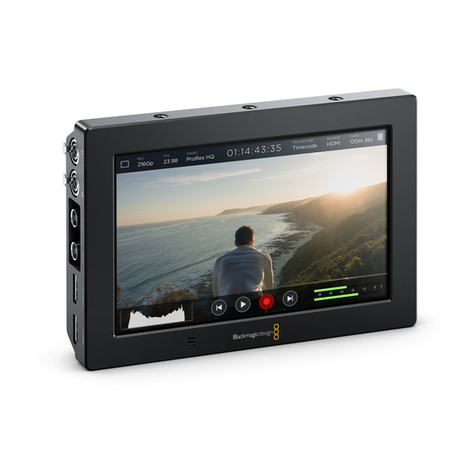
Blackmagicdesign
Blackmagicdesign Blackmagic Video assist User manual
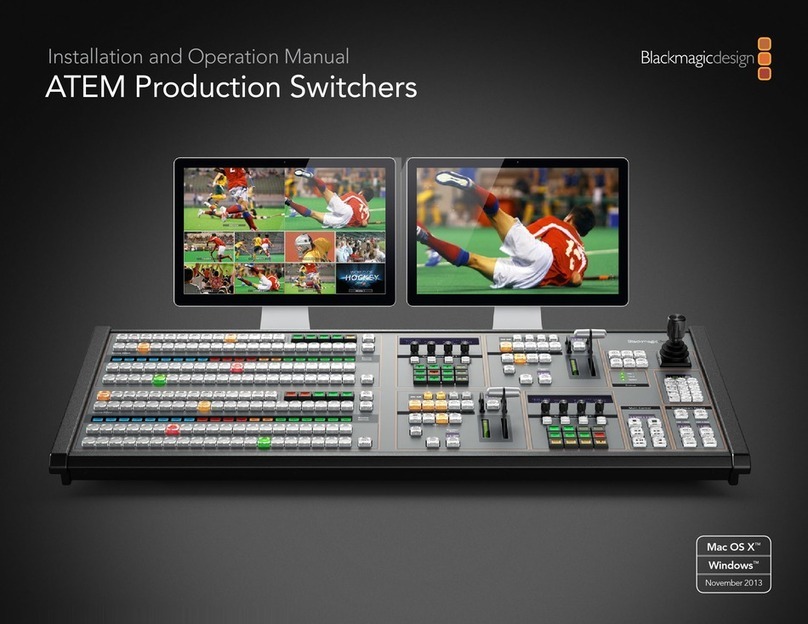
Blackmagicdesign
Blackmagicdesign ATEM Camera Converter User manual
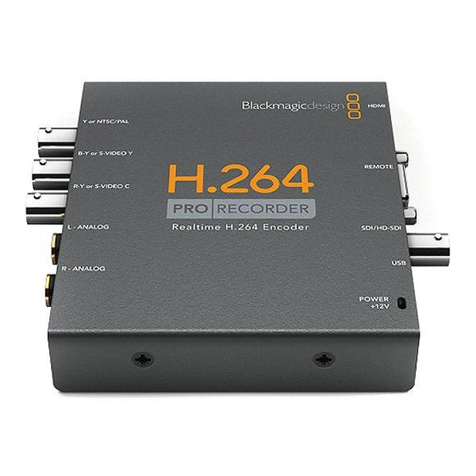
Blackmagicdesign
Blackmagicdesign H.264 Pro User manual
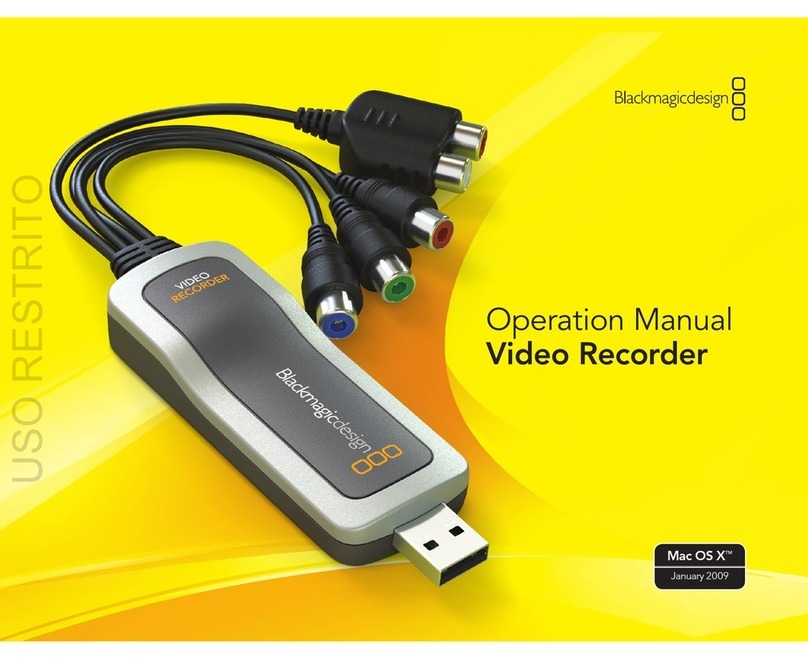
Blackmagicdesign
Blackmagicdesign Video Recorder User manual

Blackmagicdesign
Blackmagicdesign ATEM Camera Converter User manual

Blackmagicdesign
Blackmagicdesign UltraStudio Pro User manual

Blackmagicdesign
Blackmagicdesign DeckLink Series User manual
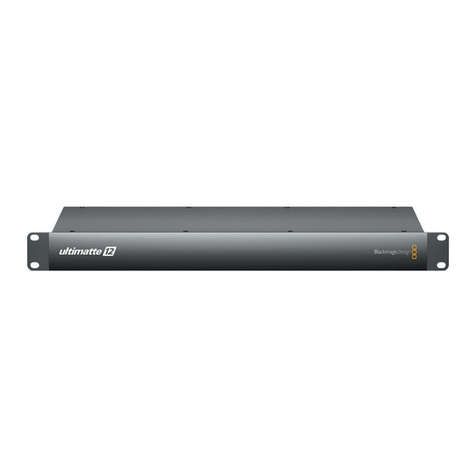
Blackmagicdesign
Blackmagicdesign Ultimatte 12 User manual
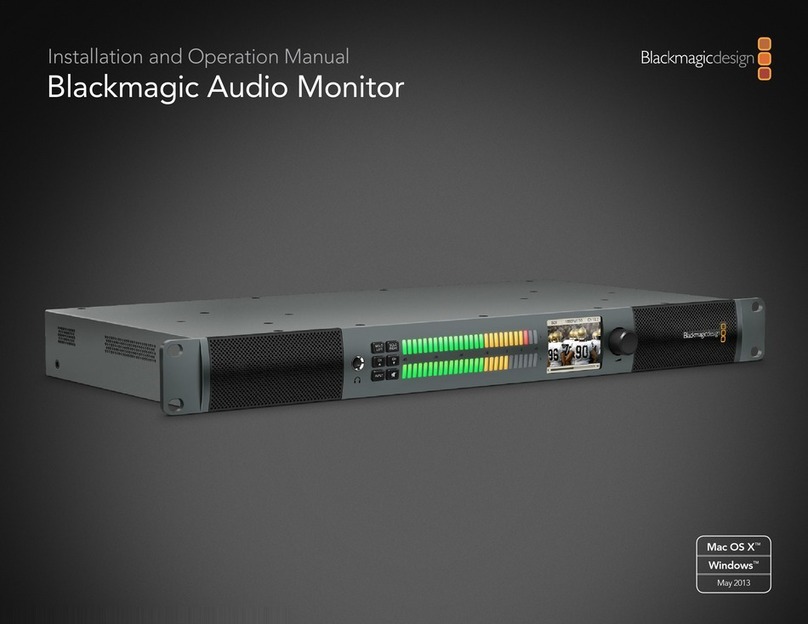
Blackmagicdesign
Blackmagicdesign Audio Monitor User manual
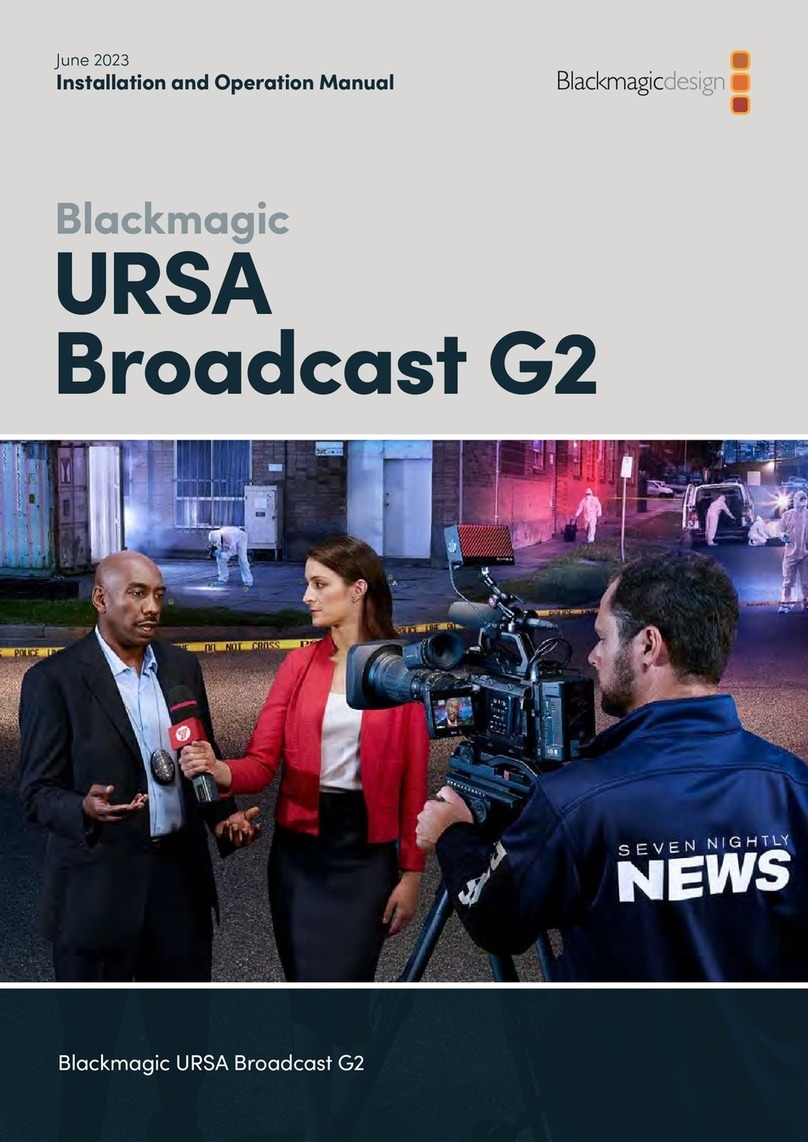
Blackmagicdesign
Blackmagicdesign URSA Broadcast G2 User manual


